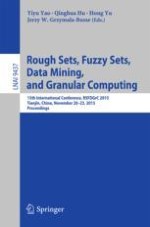2015 | Buch
Rough Sets, Fuzzy Sets, Data Mining, and Granular Computing
15th International Conference, RSFDGrC 2015, Tianjin, China, November 20-23, 2015, Proceedings
herausgegeben von: Yiyu Yao, Qinghua Hu, Hong Yu, Jerzy W. Grzymala-Busse
Verlag: Springer International Publishing
Buchreihe : Lecture Notes in Computer Science
